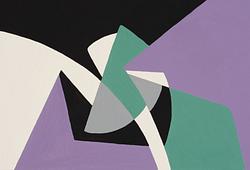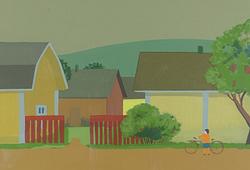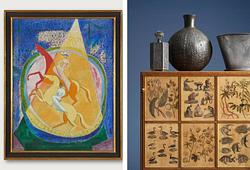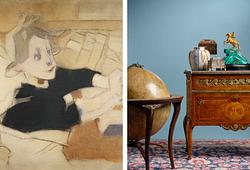Bukowskis – Where the collections are sold
Collection at Contemporary Art & Design
Behind the newly started Art for the Globe foundation is the doctor Johan Wallin, who, during his 84-year-old life, collected close to 700 original works by contemporary Swedish artists. The foundation will annually reward humanists who strengthen awareness around the environment and our fragile planet.
"I believe that all change begins with humans, in our heads, thoughts and values - a place where artists, writers and musicians reach.", says Johan Wallin.
Johan Wallin has been collecting contemporary Swedish art throughout his whole life, and 30 artworks are being auctioned at Bukowskis this autumn. Among the highlights are interesting works such as "Dramatic Theater" by Mamma Andersson, "Mohican (Linus)" by Lena Cronqvist, and "La Scala" by Jockum Nordström. Over the years, Johan Wallin has had the privilege of meeting many amazing artists. In the following stories, he shares these memorable moments.
The first part of Art for the Globe collection, themed "Music & Drama" will be sold during the Contemporary Art & Design auction on October 25.

Karin Mamma Andersson
”Dramatic Theater"
– Karin Mamma graduated from the Royal Institute of Art in 1993. I saw her exhibition at Galleri Mejan in February 1992. Remarkably beautiful and exciting. I purchased a painting. Karin was pleased. She proudly informed me that Hans Wigert had also bought one. A year later, I exhibited Karin and Hans at the Sollentuna Fair.
– Karin quickly gained appreciation from many. More and more exhibitions were scheduled. It became difficult to buy more artwork from her. The paintings were needed for exhibitions. Karin knew that I wanted another painting. So she gave me a tip: "In a few weeks, I will have some paintings in a group exhibition at Botkyrka Konsthall in Tumba Center." I headed there about a week after the opening. There hung three paintings: a very large one (which was already sold, as I later found out to Folke Lalander, then the director of Liljevalchs Konsthall), a relatively small portrait, and a medium-sized painting titled "Dramatic Theater." I bought that one.
› Signed Karin Mamma Andersson and dated 1999 verso. Oil on canvas 84 x 84 cm. Estimate 1 000 000 - 1 500 000 SEK.

Lena Cronqvist
"Mohikanen (Linus)"
– When Gallery Kavaletten celebrated its 30th anniversary with an exhibition in December 1990, Lena Cronqvist contributed with the painting "The Mohican". During my visit to her studio in Ulriksdal before the exhibition, she brought out a larger painting depicting a young man and an elegant hairdresser. "You can include this one; it has never been shown before," Lena said. I understood that the painting depicted Linus (Tunström), now a renowned theater and film director who served as the artistic director of Uppsala City Theatre from 2007 to 2016.
› Signed L. Cronqvist and dated 1986. Canvas 200 x 120 cm. Estimate 300 000 - 500 000 SEK.

Jockum Nordström
”La Scala”
– Jockum and Karin Mamma had recently moved to Harpsundsvägen in Bandhagen. They had a duplex apartment with a studio on the top floor where Jockum worked. We were invited to a family dinner with their sons Valentin and Rudolf and Karin's mother visiting from Luleå. It was a long-cooked meal, if I remember correctly.
– Jockum had a problem. One of his large paintings, "La Scala," couldn't fit in their apartment. The basement storage room was too small, and the painting was outside the hallway. We agreed it was not a secure storage place. "Can you take the painting in your truck?" Jockum asked. "Of course, but how much will it cost?" I inquired. Jockum assured me, "Don't worry about it." Indeed, it worked out, and the painting has been hanging in my home on Tomtebogatan ever since.
› Signed Jockum och dated Jan 1989 verso. Oil on canvas 124,5 x 160 cm. Estimate 175 000 - 200 000 SEK.

Erland Cullberg
"The Little Drummer"
–I was Erland Cullberg's gallerist for over 25 years. I closely followed his artistic journey with visits to his studio and home, usually 3-4 times a week. My job included providing Erland with art supplies and taking the paintings and drawings he was satisfied with to the storage unit in Sollentuna. I had a small truck (pickup) with a canopy. We spent much time enjoying coffee and pastries in his little kitchen.
–In his home, amidst half-finished paintings, messy brushes, and tubes, there was a small, originally all-white Ikea coffee table. It was usually cluttered with all sorts of things, mostly cigarette butts and unwashed coffee cups. When Erland didn't have a canvas to work on, he occasionally painted on the table. The 'subjects' constantly changed. One day, I thought I saw a boy playing the drums. I asked Erland about it, and he smiled warmly, agreeing. Apparently, he hadn't noticed it himself until now. 'Sounds good, Erland. If I buy you a new table like this one, can I take this one to the storage unit?' He gave the go-ahead. We signed the deal, loaded it into the car, and went off to the storage unit. I unscrew the legs and put it up on the wall. Voila! Another artwork by Erland Cullberg.
–When Erland needed a break (his method of working with large canvases on the floor was mentally and physically demanding), he drew with charcoal or crayons. He quickly filled up a sketchbook with 50 pages. During my visits, we always went through what he had created. Most of it was just drafts, quick strokes that he abandoned. But then there would be 3 or 4 fully realized drawings that he was proud of. We tore those out, Erland signed them, and we brainstormed titles. Erland was well-read in his way, a subscriber to DN (Dagens Nyheter, a Swedish newspaper) that he 'read' daily through a quick scan. He was incredibly receptive. His titles often referenced culture (Shakespeare would pop up in the most unexpected contexts) or current social phenomena. The titles of the drawings are representative of the cultural department.
› Signed E Cullberg. Performed 1998. Oil on wood 111 x 45 cm. Estimate 20 000 - 25 000 SEK.
The works from the collection are sold at Contemporary Art & Design

Art for the Globe Collection

Vasarahinta
14 000 SEK
Lähtöhinta
6 000 - 8 000 SEK
For requests & condition reports Contact our category specialists

Tukholma
Louise Wrede
Asiantuntija, nykytaide, Private Sales
+46 (0)739 40 08 19
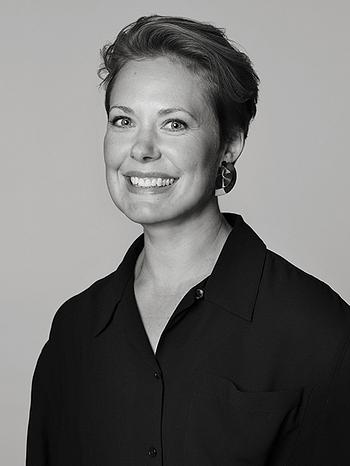
Tukholma
Karin Aringer
Asiantuntija – nykytaide ja valokuva
+46 (0)702 63 70 57




